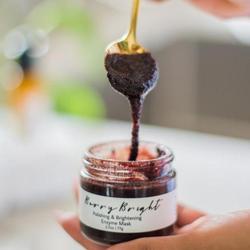
Berry Bright Polishing & Brightening Enzyme Mask
Ingredients overview
Highlights
Key Ingredients
Skim through
| Ingredient name | what-it-does | irr., com. | ID-Rating |
|---|---|---|---|
| Raw Honey | soothing, moisturizer/humectant, antimicrobial/antibacterial | goodie | |
| *Cranberry Powder | antioxidant | ||
| *Blueberry Powder | |||
| *Aronia Berry Power | |||
| Lactobacillus Ferment | soothing, preservative | goodie | |
| Lactobacillus | |||
| Coconut Fruit Extract | emollient | ||
| *Horsetail | soothing, emollient | ||
| Hibiscus Flower Extract | |||
| *Frankincense Essential Oil | |||
| Lemon Essential Oil | perfuming | icky |
Me Time Botanicals Berry Bright Polishing & Brightening Enzyme MaskIngredients explained
We all know honey as the sweet, gooey stuff that is lovely to sweeten a good cup of tea and we have good news about putting honey all over our skin. It is just as lovely on the skin as it is in the tea.
The great review article about honey in the Journal of Cosmetic Dermatology writes that it is arguably the oldest skincare ingredient and evidence from around 4500 BC mentions honey in some eye cream recipes. Chemically speaking, it is a bee-derived, supersaturated sugar solution. About 95% of honey dry weight is sugar and the other 5% consists of a great number of other minor components including proteins, amino acids, vitamins, enzymes, and minerals.
This ingredient name is not according to the INCI-standard. :( What, why?!
This ingredient name is not according to the INCI-standard. :( What, why?!
Lactobacillus ferment is an interesting probiotic ingredient with some promising properties.
First, according to a 2009 Estee Lauder patent, it’s a DNA repair enzyme and it can help to protect the skin against environmental aggressors.

The extract coming from the coconut fruit. It is a similar thing to coconut water and fruit juice and is loaded with sugars, minerals, amino acids. It is also claimed to have vitalizing and energizing effects, and some smoothing, emollient and hydrating props.
If you are into coconut, we have more details at coconut water and coconut oil.



The essential oil coming from the rind of the lemon that we make (or should make) lemonade from. In general, there are two problems with citrus peel oils: first, they are essentially the fragrant component, limonene in disguise (they are about 85-98% limonene).
Second, they contain the problematic compounds called furanocoumarins that make them mildly phototoxic. Lemon peel contains a medium amount of them, more than sweet orange but less than bergamot. Be careful with it especially if it is in a product for daytime use.
You may also want to take a look at...
| what‑it‑does | soothing | moisturizer/humectant | antimicrobial/antibacterial |
| what‑it‑does | antioxidant |
| what‑it‑does | soothing | preservative |
| what‑it‑does | emollient |
| what‑it‑does | soothing | emollient |
| what‑it‑does | perfuming |





